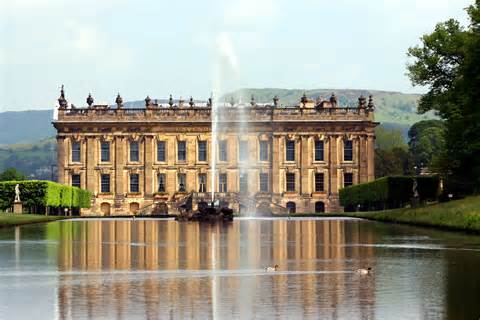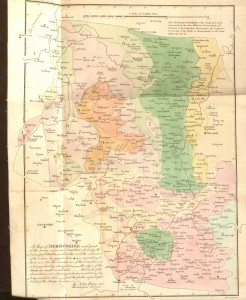
September 5, 2014, by James
Getting into the archive – Weather and the Great Estate: the recording of rainfall at Chatsworth House, Derbyshire, 1760 to the Present
Agricultural societies, farmers clubs and contemporary literature in the eighteenth and nineteenth centuries.
In the eighteenth and nineteenth centuries, agriculturalists, landowners and farmers in Britain were increasingly literate and open to new ideas, leading to the growth in the number of farming books and the establishment of agricultural periodicals. Literature concerning agriculture and rural life explored the significance of weather and climate and was one way in which knowledge of the subject was disseminated. The farming community was increasingly educated and innovative and they played an important role in observing and recording the weather in the same way that clergymen or parsons, doctors and physicians, gardeners, gentlemen, naturalists and landowners did. Agricultural societies and farmers clubs which were firmly established from the 1840s presented another opportunity where knowledge of weather and climate could be diffused, often having extensive libraries which farmers could access and providing a forum for discussion.[1] Contemporary literature concerning agriculture and everyday rural life provided insight into the effects of weather and climate and offered practical advice that could be followed. Periodicals, such as, the Annals of Agriculture published between 1784 and 1815, and the Journal of the Royal Agricultural Society of England included contributions on weather and climate. With regard to the latter, a ‘Prize Essay’: ‘On the Climate of the British Islands in its Effects on Cultivation’ (see extract below) written by Nicholas Whitley, a surveyor from Truro, Cornwall observed there were three primary elements necessary for successful agriculture, ‘skill-full husbandry, a well constituted soil, and a genial climate’, the latter being ‘beyond man’s control.’[2] Furthermore, of climate he observed: ‘It is man’s master exacting submission, not his servant obeying his behests’, questioning the importance of knowledge of the subject given man’s inability to control it.[3] He emphasised the need to adapt to climate which he went as far as arguing was the ‘ruling principle of agriculture’, governing the agricultural production of countries and that those ‘who yields the most enlightened obedience obtains the largest reward.’[4] Similarly, the ‘Prize Reports’, divide counties into districts, describing the climate of each in detail and often including instrumental data. For example the prize report for Shropshire written by Humphrey Tanner, includes a series of tables presenting the climate of each month, the climate of each separate year (1848-1857), the variation in temperature, pressure and dew point by season and the direction and strength of the prevailing wind.[5]
‘1. There are three primary elements necessary to the success of agricultural operations – skilful husbandry, a well constituted soil, and a genial climate. The first of these is now placed within the reach of every intelligent man, and depends on the application of his own skill and industry; the constitution of the soil is in general well adapted by nature for the functions it has to perform, and where it is defective, its composition may be corrected and its productive powers increased; but the elements which constitute climate appear to be beyond man’s control; he is comparatively powerless to mitigate its rigour, or to add to its generous influence. It is man’s master exacting submission, not his servant obeying his behests. Of what avail then, it may be to the power we cannot control, and learn to adapt our culture to the capabilities of climate: indeed climate is the ruling principle of agriculture – the law which governs the productions of different countries, and he who yields the most enlightened obedience obtains the largest reward.’ N. Whitley, ‘On the Climate of the British Islands in its Effect on Cultivation’, Journal of the Royal Agricultural Society, Volume 11 (1850), 1
The Board of Agricultural Reports, or General Views.
The Board of Agricultural Reports, or General Views, typically give a description of a county’s climate and also makes reference to the recording of the weather. In the first volume for Derbyshire written by the geologist and surveyor John Farey (1766-1826) published in 1811, there is a detailed discussion about the climate of the county and included is an accompanying map showing the places referred to in the text, as well as the underlying soils and strata.[6]

Map of Derbyshire. Source: J. Farey, General View of the Agriculture and Minerals of Derbyshire, Volume 1 (London, B. McMillan, 1811).
He highlighted the significance of the difference in height between the High and Low Peak and the implications this had for temperature. It was noted that ‘violent storms’ and ‘ravages committed on lands by torrents of rain’ were not very common in the Peaks and ‘the snows’ began to fall in the autumn and continued until late spring by ten days or a fortnight difference.[7] The timing of the harvest is referred to, as at Hartington, he was informed that the harvest of corn and hay was two weeks later than in around Derby, and that it was reported that corn frequently remained in the fields of the High Peak until Christmas. Farey himself observed oats standing in a field covered by snow on the 25 November 1808, although he came to the conclusion that this was the result of ‘the effect of neglect and mismanagement on the part of the Farmer.’[8] He was informed at Ashover that early and severe autumn frosts were not an indication of a severe winter, that frosts after wet weather tended not to continue for long, and that when the wind blew south or south-west it frequently rained between twelve and three o’clock. Farey referred to having witnessed farmers consulting a printed table concerning the weather, presumably published in the aforementioned periodical literature. Although he pointed out that there were few daily registers of barometer readings, he noted ‘yet there are very few farmers indeed, who are not furnished with this useful instrument, and who no doubt often carefully observe its state as to rising or falling, and whether above or below the point of “changeable.”[9]
Chatsworth House, Derbyshire.
Accompanying his account of the climate of Derbyshire is a register of rainfall for the period 1761 to 1810 kept at Chatsworth House, the estate of the Devonshire family. This is discussed in-depth. Farey complemented His Grace the Duke of Devonshire – ‘the noble owner of Chatsworth for persevering with this Register of the Rain’, and he suggested that other noblemen and gentlemen should do the same.[10]

Register of rainfall kept at Chatsworth House, Derbyshire. Source: J. Farey, General View of the Agriculture and Minerals of Derbyshire, Volume 1 (London, B. McMillan, 1811), 99.
Thomas Knowlton (1691-1781) the estate agent and notable gardener who lived at the nearby village of Edensor was also credited.[11] Such registers he argued would ‘in time prove of the greatest importance, as the foundation of a Science of Meteorology.’[12] Contemporaries tried to link changing patterns in the weather and climate, for instance a reduction in rainfall and an increase of humid weather to the cutting down of woodland, the decrease of furze, heath and other indigenous plants due to enclosure. The Chatsworth series can be reconstructed by using published and unpublished data, which can be supplemented with further precipitation records provided by William Milnes at Ashover and Mr. Thomas Swanwick, of the Commercial Academy, in St. Mary’s Gate, Derby who made meteorological observations and stations further afield, providing useful comparison.

‘Eleven years abstracts and averages of meteorological observations made at Derby, Lat. 52o 58o N., Lon. 1o 32o W: about 170 feet above the level of the sea; by the late Mr. Thomas Swanwick, of the Commercial Academy, who died in March 1814.’ Source: J. Farey, General View of the Agriculture and Minerals of Derbyshire, Volume 3 (London, B. McMillan, 1811), 685.
As with the promotion of new farming practices, improvements in estate management and the construction of farm buildings, the recording of weather data seems to have been pioneered by the large estates like Chatsworth. The recording of early instrumental meteorological data, such as, barometric pressure, temperature, rainfall, wind direction and strength provides valuable quantitative data as to the nature of the weather and climate in the past and can be used to recover local climate histories. The weather is still recorded daily at 9am by a gardener at Chatsworth, and this data is accessible through ‘The British Atmospheric Data Centre’ (BADC) from 1878 to the present.
References
- [1] The Royal Agricultural Society of England was founded in 1838 and granted its Royal Charter by Her Royal Highness Queen Victoria in 1840, its motto was: ‘practice with science.’
- [2] N. Whitley, ‘On the Climate of the British Islands in its Effect on Cultivation’, Journal of the Royal Agricultural Society, Volume 11 (1850), 1-65.
- [3] Whitley, ‘Climate of the British Islands’, 1.
- [4] Whitley, ‘Climate of the British Islands’, 1.
- [5] H. Tanner, ‘The agriculture of Shropshire ‘, Journal of the Royal Agricultural Society, Volume 19 (1858), 1-64.
- [6] J. Farey, General View of the Agriculture and Minerals of Derbyshire, Volume 1 (London, B. McMillan, 1811), 95-105; H.S. Torrens, ‘Farey, John (1766–1826)’, Oxford Dictionary of National Biography, Oxford University Press, 2004; online edn, May 2008 [http://www.oxforddnb.com/view/article/9154, accessed 7 Aug 2014].
- [7] Farey, General View, 96.
- [8] Farey, General View, 96.
- [9] Farey, General View, 97.
- [10] Farey, General View, 103.
- [11] T. Seccombe, ‘Knowlton, Thomas (1691–1781)’, rev. P.E. Kell, Oxford Dictionary of National Biography, Oxford University Press, 2004; online edn, Sept 2012 [http://www.oxforddnb.com/view/article/15777, accessed 4 Sept 2014]
- [12] Farey, General View, 103. For more information see: http://www.parksandgardens.org/places-and-people/person/775.
No comments yet, fill out a comment to be the first


Leave a Reply